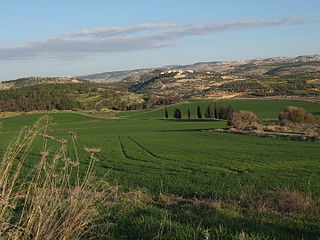
Midrash is biblical exegesis by ancient Judaic authorities, using a mode of interpretation prominent in the Talmud.

Vayetze, Vayeitzei, or Vayetzei is the seventh weekly Torah portion in the annual Jewish cycle of Torah reading. It constitutes Genesis 28:10–32:3. The parashah tells of Jacob's travels to, life in, and return from Haran. The parashah recounts Jacob's dream of a ladder to heaven, Jacob's meeting of Rachel at the well, Jacob's time working for Laban and living with Rachel and Leah, the birth of Jacob's children, and the departure of Jacob's family from Laban.

Midrash Tanhuma is the name given to three different collections of Pentateuch aggadot; two are extant, while the third is known only through citations. These midrashim, although bearing the name of R. Tanḥuma, must not be regarded as having been written or edited by him. They were so named merely because they consist partly of homilies originating with him and partly of homilies by aggadic teachers who followed the style of R. Tanḥuma. It is possible that R. Tanḥuma himself preserved his homilies, and that his collection was used by the editors of the midrash. The three collections were edited at different times; they will, therefore, be treated in chronological order.

Exodus Rabbah is the midrash to Exodus.
Samuel ben Nahman or Samuel [bar] Nahmani was a rabbi of the Talmud, known as an amora, who lived in the Land of Israel from the beginning of the 3rd century until the beginning of the 4th century.
Luliani ben Tabrin was a Jewish scholar of the beginning of the fourth century, one of the amoraim living in the Land of Israel.

Pesikta Rabbati or P'siqta Rabbita is a collection of aggadic midrash (homilies) on the Pentateuchal and prophetic readings, the special Sabbaths, and so on. It was composed around 845 CE and probably called "rabbati" to distinguish it from the earlier Pesikta de-Rav Kahana (PdRK).

Pesikta de-Rab Kahana is a collection of aggadic midrash which exists in two editions, those of Solomon Buber and Bernard Mandelbaum (1962). It is cited in the Arukh and by Rashi.

Midrash Tehillim, also known as Midrash Shocher Tov or the Midrash to Psalms, is an aggadic midrash to Psalms.
Tanhuma bar Abba was a Jewish amora of the 5th generation, one of the foremost aggadists of his time.

The Midrash on Lamentations or Eichah Rabbah is a midrashic commentary to the Book of Lamentations ("Eichah").

Ecclesiastes Rabbah or Kohelet Rabbah is an aggadic commentary on Ecclesiastes, included in the collection of the Midrash Rabbot. It follows the Biblical book verse by verse, only a few verses remaining without commentary.

Deuteronomy Rabbah is an aggadah or homiletic commentary on the Book of Deuteronomy.

Midrash Petirat Moshe or Midrash on the Death of Moses is one of the smaller midrashim. This midrash describes in great detail the last acts of Moses and his death, at which the angels and God were present. There are several recensions of it, dating to between 7th and 11th centuries. The first, published at Constantinople in 1516 begins with a brief exegesis by R. Samuel Naḥmani and R. Tanhuma of the first verse of the pericope "V'Zot HaBerachah", closing with its last verses, and doubtless intended for Simhat Torah.

Midrash Samuel is an aggadic midrash on the books of Samuel.
Levi II, or Rabbi Levi was a Jewish-Palestinian scholar of the 3rd century. In a few cases he is quoted as Levi bar Laḥma (Hama). In later midrashim the title "Berabbi" is sometimes added to his name.

Yalkut haMachiri is a work of midrash. Its author was Machir ben Abba Mari, but not even his country or the period in which he lived are definitively known. Moritz Steinschneider supposes that Machir lived in Provence; but the question of his date remains a subject of discussion among modern scholars. Strack & Stemberger (1991) indicate that the work was most probably composed in the late 13th or 14th century.

Allusions in rabbinic literature to the Biblical character Job, the object of sufferings and tribulations in the Book of Job, contain various expansions, elaborations and inferences beyond what is presented in the text of the Bible itself.
Eleazar ha-Kappar was a Jewish rabbi of the fifth and last generation of the Tannaim era. He was a colleague of Judah haNasi, and was in the company of him occasionally. He spent most of his life at ancient Katzrin. He was the father of Bar Kappara, who is sometimes cited by the same name. He had a nephew named Hiyya, who was known for his pleasant voice.
Rabbi Isaac Nappaha, or Isaac the smith, was a rabbi of the 3rd-4th centuries who lived in the Galilee.



